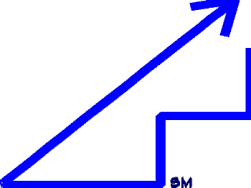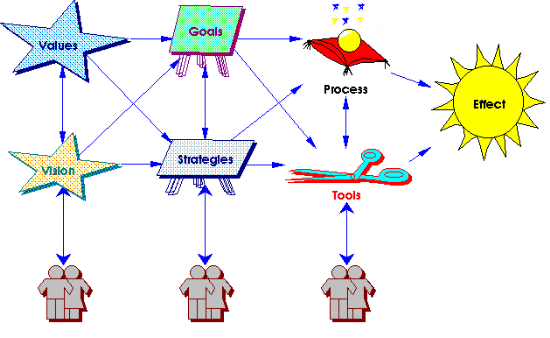The "Customer Effect" SystemProcess is just one of the things that make a business organization go. It is important, because what customers perceive, tangibly, is the result or effect of the way we use our tools and our processes to provide them with a service. That’s the front end, what the customer sees. The way we use our tools (two things there: "the way we use" = process, and "our tools" = packaging, materials and product) creates the effect that draws and keeps customers.But the system is deeper than that. Behind the processes and tools we use are the goals and strategies we have decided (consciously or unconsciously) to act upon. The processes and the tools that we use are consistent with the goals and strategies we are working toward. We can achieve goals and follow strategies when the processes and tools we use are consistent with those goals and strategies. When there are inconsistencies we have difficulties.Beyond goals and strategies are the values and vision that determine what goals and strategies we will pursue. How we set our goals and select our strategies depends on what we see in the future and what we value, what we wish to see in the world.This is a highly interconnected system of drivers that lead to providing an "effect" to our customer. If our values change, as they will based on experience and changing values in the culture, our vision of the future will change. These changes will require us to rethink our goals and the strategies we’re following to reach those goals. When the goals and strategies change the processes and tools we use to provide the "effect" for our customers will change. The system always operates, turning out "effects". If there are discrepancies between, for example, vision and goals, the effect will be disappointing; discrepancies between tools and process cause rework and the effect on the customer is disappointing.
We work on process because this is where the effect is really created. For example, with painting the effect is the result of the artist’s technique, their process for painting. We recognize a Picasso regardless of the materials he used to paint with, regardless of the particular brushes he selected. Process is where the other parts of the system are synthesized, this is where the effect is created. However, the process will create an effect that is exactly consonant with the rest of this system: values, vision, goals, strategies, and tools. A Picasso is identifiable precisely because of Picasso’s vision, values, goals, strategies, tools, and process for producing paintings, his technique. This is why imitators usually fail: the system is too deep, too complex to reproduce. So they concentrate on duplicating the tools and the process and their effect is clearly an inferior imitation, because the rest of the parts of the system were different.Process is malleable, we can adapt it easily to fit our tools; but more important, we can adapt it easily to fit strategies, goals, vision and values. We can compensate to some degree for misalignment among these factors by adjusting our processes and using our tools differently. However, where there are large differences between these factors it is necessary to look at the whole system and bring all the factors into conscious balance. Organizations sometimes need to go through this massive re-evaluation of their purpose, means and effect. Whether it’s called "re-engineering" or happens because of a merger or a buy-out, rebuilding the drivers among these factors will preoccupy an organization. Customers will notice the change in effect. It is healthier for an organization to periodically test and tune these factors to protect and improve the effect for the customer. This can be done by evaluating process, using process as a window into the other factors in the system. Whether the technique is benchmarking, assessment or audit, the purpose is to bring these factors into alignment so that the organization's effect on the customer is the effect the organization and the customer wants.กก |

